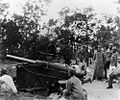Minimal chart cannon
Minimalschartenkanon is a technical term used in artillery, especially fortress artillery .
In order to keep the cannon slot for the gun barrels in armored dome and casemate cannons as small as possible (minimal slot), a special mount was constructed, which was provided with a gun barrel and was called a "minimal slot cannon" (minimal slot cannons were available in different calibers and barrel types - each as required or availability). The breakthrough through the wall of the casemate was only a little larger than the outer diameter of the gun barrel, this only protruded a little bit outwards. In order to ensure the side and elevation range, a special gun carriage was necessary, which was designed in the form of a "T". The longitudinal beam of the T carried the gun barrel, pointed to the notch opening and was at the front end on the pivot pin, which was located directly under the cannon slot. The crossbar of the T rested on wheels that moved with the gun carriage in a semicircle around the pivot pin. This ensured the side straightening area. Since the gun barrel could not move around its trunnion in the elevation area , it was raised or lowered along its entire length like a lever with the help of the special barrel cradle .
As a result, the fulcrum of the gun was directly on the inside of the wall and the goal of a minimal opening was achieved.
The principle was also used in the Casemates Mougin from 1874 in French forts.
example
source
- Łukasz Chrzanowski: Artyleria Austro-Węgierska 1860–1890. Wydawnictwo FORT, Przemyśl 2008, ISBN 978-83-923657-7-8 .
- Erwin Anton Grestenberger: Imperial and Royal fortifications in Tyrol and Carinthia 1860–1918. Verlag Österreich ua, Vienna 2000, ISBN 3-7046-1558-7 .




